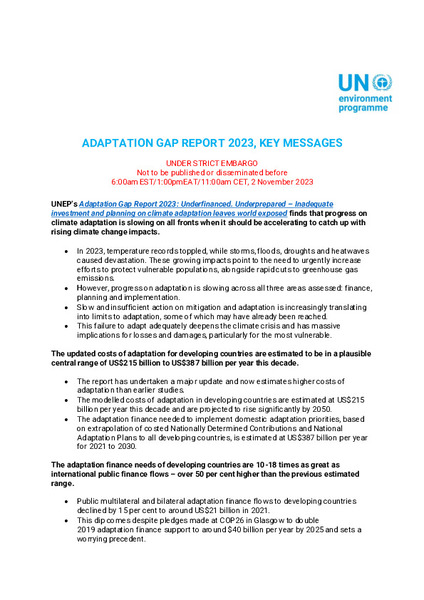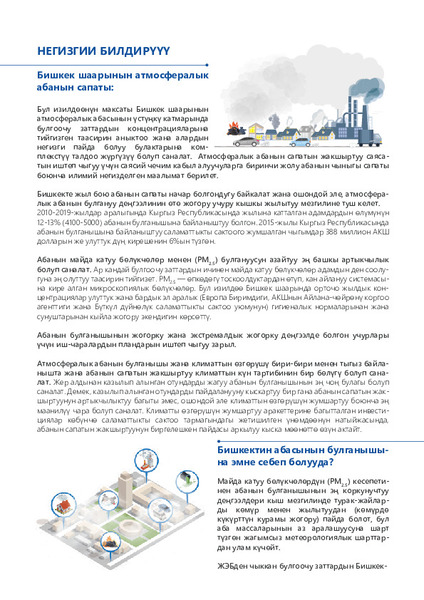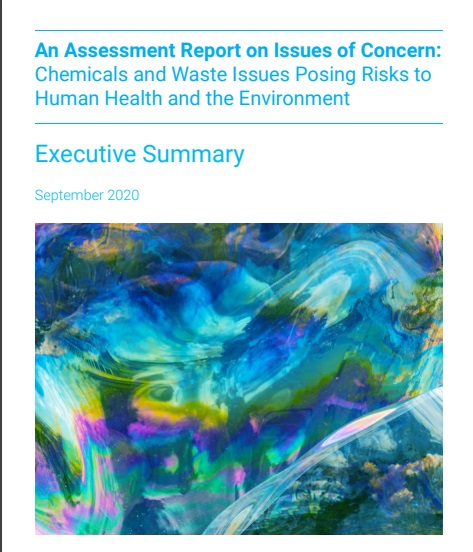Browsing Briefs, Summaries, Policies and Strategies by Language "Russian"
Now showing items 1-20 of 82
-
Actions on Air Quality: Executive Summary - Global
(2021)This global report provides a review of policy actions of Member States per the mandate provided by UNEA Resolution 3/8 on Preventing and reducing air pollution to improve air quality globally. It builds on the United ... -
Adaptation Gap Report 2020 - Executive Summary
(2021)In the lead-up to the Global Stocktake in 2023, the AGR aims to address three important questions: What are we doing today to adapt? To what extent are we currently reducing climate risks? To what extent will our adaptation ... -
Adaptation Gap Report 2023 - Key Messages
(2023-11) -
Air Quality in Bishkek – Assessment of Emission Sources and Road Map for Supporting Air Quality Management: Key Messages
(2022-10)This study is the first comprehensive analysis of key emission sources and their impact on ground-level air pollution concentrations in Bishkek, thus providing decision-makers for the first time with scientific evidence ... -
An Assessment Report on Issues of Concern: Chemicals and Waste Issues Posing Risks to Human Health and the Environment - Executive Summary September 2020
(2021-03)This report responds to Resolution 4/8 by the United Nations Environment Assembly (UNEA) and aims to inform the international community about the current situation of specific issues of concern, based on a review of evidence ... -
Becoming #GenerationRestoration: Ecosystem Restoration for People, Nature and Climate - Key Messages
(2021)1. Countries need to deliver on their existing commitments to restore 1 billion hectares of degraded land and make similar commitments for marine and coastal areas. 2. Unfortunately, we are still going in the wrong direction. ... -
A Case of Benign Neglect: Knowledge Gaps About Sustainability in Pastoralism and Rangelands - Executive Summary
(2019)Pastoralism is practiced by millions of people worldwide. It has roots in every part of the world and back thousands of years to the beginning of agriculture. But while pastoral societies have existed for millennia, we ... -
Climate Change 2007: The Physical Science Basis; Contribution of Working Group I to the Fourth Assessment Report of the Intergovernmental Panel on Climate Change - Summary for Policymakers
(Cambridge University Press, 2007)The Working Group I contribution to the IPCC Fourth Assessment Report describes progress in understanding of the human and natural drivers of climate change, observed climate change, climate processes and attribution, and ... -
Cold Chain Technology Brief: Vaccines
(2021)This note provides an overview of the vaccine cold chain in general and COVID-19 in particular, its requirements and challenges. First, the effects of temperature on these vaccines, old and new, and their storage and ... -
Coral Reef Restoration to Improve Ecosystem Services - Policy Brief
(2021)Coral reef restoration is becoming a popular tool to assist the recovery of damaged coral reefs. Over the last twenty years, several methods have been developed and applied with varying levels of success. A recent report ... -
COVID-19, the Environment and Food Systems: Contain, Cope, and Rebuild Better - Executive Summary
(2020)The Covid-19 pandemic is increasing poverty and threatening food security. Governments around the world have already invested more than $12 trillion to counteract the economic effects of COVID-19. This investment could ... -
COVID-19, the Environment and Food Systems: Contain, Cope, and Rebuild Better - Key Messages
(2020)Governments around the world have invested about $12 trillion to counteract the economic effects of COVID-19. This investment could contribute to progress on the Sustainable Development Goals (SDGs) and global climate ... -
Economic Valuation of Wastewater - Executive Summary
(2015)This is executive summary of a book that presents the results of an analytical study of the economic assessment of wastewater, comparing economic losses from inaction to the cost of effective wastewater management. -
-
Emissions Gap Report 2019 - Executive Summary
(2019)This tenth edition of the United Nations Environment Programme (UNEP) Emissions Gap Report provides the latest assessment of scientific studies on current and estimated future greenhouse gas (GHG) emissions and compares ... -
Emissions Gap Report 2020 - Executive Summary
(2020)As in previous years, this report assesses the gap between estimated future global greenhouse gas (GHG) emissions if countries implement their climate mitigation pledges and the global emission levels from least-cost ... -
Emissions Gap Report 2020 - Frequently Asked Questions
(2020)This document addresses the following questions: Emissions Gap Report 2020 – what is it? What are the headlines? What’s the bottom line? What can we do to catch up? Are governments doing enough? Does the report tell us ... -
Emissions Gap Report 2020 - Key Messages
(2020-12)Despite a brief dip in carbon dioxide emissions caused by the COVID-19 pandemic, the world is still heading for a temperature rise in excess of 3°C this century – far beyond the Paris Agreement goals of limiting global ... -
Emissions Gap Report 2021 - Key Messages
(2021-10)The Emissions Gap Report 2021: The Heat Is On shows that the new Nationally Determined Contributions (NDCs), combined with other mitigation pledges, put the world on track for a global temperature rise of 2.7°C by end of ... -
Emissions Gap Report 2021: The Heat Is On – A World of Climate Promises Not Yet Delivered: Executive Summary
(2021)Each year, the Emissions Gap Report provides an updated assessment of the gap between i) estimated future global GHG emissions if countries implement their climate mitigation pledges and ii) the global emission levels from ...





















